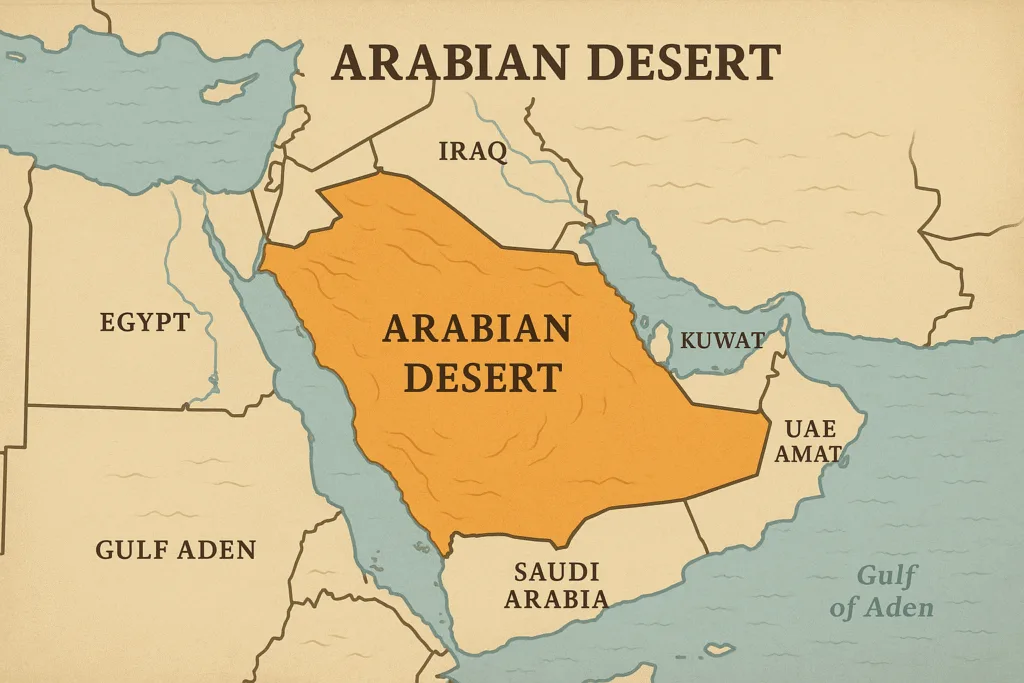Location & Continent
Continent: Asia
Countries: China, Mongolia
Coordinates: 42°N, 105°E
Thar Desert – Map & Street View
Photos of the Gobi Desert

Physical Features
Area: Around 1.3 million km² (one of the largest deserts in the world)
Length: Roughly 1,600 km
Width: Around 800 km
Elevation: Varies between 900 and 1,500 m above sea level
Climate & Precipitation
Temperature: Summers can reach 45°C, while winters can drop to −40°C
Precipitation: 50–200 mm per year on average; most areas receive less than 100 mm
Ecological Features
Ecozone: Cold desert and semi-arid steppe
Biome: Temperate desert and grassland
Ecoregions: Eastern Gobi Desert Steppe, Alashan Plateau Semi-Desert, Gobi Lakes Valley Desert Steppe
Flora & Fauna
Flora: Drought-resistant shrubs, sagebrush, salt-tolerant plants, and sparse grasses
Fauna: Bactrian camels, Gobi bears (one of the rarest bears on Earth), snow leopards, gazelles, jerboas, and various bird species
Geology & Notable Features
Geology: Composed of gravel plains, rocky outcrops, sand dunes, and dry basins; contains fossil-rich sedimentary formations
Notable Features: Flaming Cliffs (Bayanzag) known for dinosaur fossils, Khongoryn Els Sand Dunes, Nemegt Basin, Yolyn Am (Vulture’s Valley)
Introduction
The Gobi Desert is one of the most fascinating and expansive deserts in the world, spanning across northern China and southern Mongolia. Known for its harsh climate and diverse landscapes, the Gobi Desert offers a unique glimpse into the natural world’s resilience. In this article, we will delve into the geography, climate, flora and fauna, and cultural significance of the Gobi Desert.
Geography
The Gobi Desert covers an impressive area of approximately 1.3 million square kilometers, making it the fifth largest desert in the world. The geographic features of the Gobi include vast stretches of sand dunes, mountainous regions, and rocky landscapes.
This desert is bordered by the Altai Mountains to the northwest and the Liaoning Province to the southeast. It also includes various significant terrains, such as the Gobi Altai, the Ordos Desert, and regions rich in paleontological sites.
Key Geographic Features of the Gobi Desert
| Feature | Description |
|---|---|
| Sand Dunes | Comprising extensive areas of shifting sand, like the Khongoryn Els. |
| Mountain Ranges | Including the Gobi Altai and Khangai Mountains. |
| Paleontological Sites | Famous for dinosaur fossils and other ancient life forms, located mainly in the fluvial deposits. |
Climate
The climate of the Gobi Desert is classified as a continental desert climate, characterized by extreme temperature variations between seasons. Summers can reach highs of 40°C (104°F) while winters can plunge to lows of -40°C (-40°F).
Annual precipitation in the Gobi averages between 100 to 200 mm, making it one of the driest deserts in the world. Most of the rainfall occurs during the summer months, which contrasts sharply with the severe dryness found during winter.
Seasonal Temperature Variations
| Season | Average Temperature (°C) | Weather Conditions |
|---|---|---|
| Winter (Dec – Feb) | -20 to -40 | Cold, dry, with occasional snowfall |
| Spring (Mar – May) | 0 to 20 | Warming, with sporadic rain |
| Summer (Jun – Aug) | 20 to 40 | Hot, dry, with increased rainfall |
| Autumn (Sep – Nov) | 5 to 15 | Cooling, dry with clear skies |
Flora and Fauna
The biodiversity of the Gobi Desert is surprisingly rich given its harsh climate. The ecosystem consists of over 1,000 species of plants, many of which are xerophytes—plants adapted to survive in dry conditions. Some notable plant species include the Saxaul tree and Gobi mugwort.
In terms of fauna, the Gobi is home to various unique species, including:
- Bactrian camels – adapted to desert life with their double-humped backs.
- Gobi ibex – a mountain goat that is well adapted to cliff-dwelling.
- Snow leopards – elusive predators that roam the mountainous regions.
- Gobi bear – one of the rarest bear species in the world, critically endangered.
Cultural Significance
The Gobi Desert holds profound significance for the cultures that have developed around it. Nomadic tribes, such as the Mongols, have thrived in this unforgiving landscape for centuries, utilizing their deep understanding of the desert’s ecosystems.
The Gobi is often associated with the historic Silk Road, serving as a critical trade route connecting China to the West, thus facilitating cultural exchanges and economic activities. Today, it remains a site of interest for researchers, explorers, and adventure tourists.
Conclusion
The Gobi Desert is a remarkable natural wonder that showcases nature’s resilience and adaptability. With its extreme climate, diverse life forms, and rich cultural heritage, it serves as a lens through which we can understand environmental challenges and the indomitable spirit of human existence in adversity.


